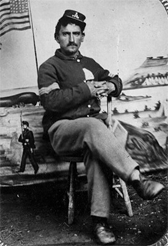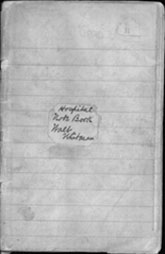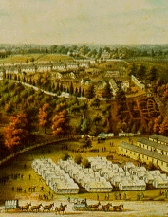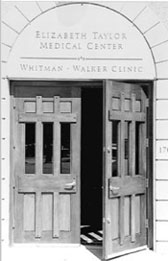"shall we ever get histories of the real things?"

Whitman in 1864

George Washington Whitman
Courtesy Duke
University Library

Courtesy of the LOC's
American Memory Collection
notebook where he attached
a newspaper clipping listing
Washington hospitals. Click
here to
see a larger version.
Courtesy of the LOC's
American Memory
Collection

Finley Hospital was one of
the hospitals Whitman visited.
Courtesy of the National
Library of Medicine
When word reached the Whitman family in December 1862 that Walt's brother George had been wounded in the battle of Fredericksburg, the poet rushed to Virginia. Once reassured that his brother's wound was superficial, Whitman helped convey other wounded soldiers from near the front to Washington D.C. hospitals. In the months and years that followed, Whitman became an attentive visitor at these hospitals. In the midst of activity, he brought memory to the fore, consciously recording experiences as they were happening, jotting down anecdotes, special requests, and especially names and addresses, in little notebooks. As the suffering increased, he became increasingly convinced that the hospitals contained the true meaning of the war.
Martin Murray's annotations of Memoranda enrich this site and help us reconstruct much more about the specific lives Whitman feared would be forgotten. Murray's archival work has unearthed information such as the age, rank, marital status, and nationality, of many of the men who fundamentally shaped Whitman's view of the war. Whitman strove to exude a buoyant, healthy personality as he brought these men oranges, stamps and stationary, tobacco, small change, ice cream, friendship, and love. He visited the wards almost daily, often writing letters for the soldiers. He addressed himself to the emotional needs of soldiers while doctors worked (often with disastrous results) on soldiers' bodies. Given that pre-antiseptic medical intervention was as likely to cause infection as to heal, Whitman's ministrations were the more effective of the two.
In Whitman's visits to approximately 100,000 soldiers, his passionate devotion to young men found a socially sanctioned outlet. Whitman projected a curiously mixed grandfatherly / avuncular / maternal aura. At times Whitman's attachment to the soldiers was palpably romantic. The ambiguity and fluidity of his roles can be seen in the way he addresses soldiers and in their responses to him. The vast preponderance of the evidence--both the testimony of people who saw Whitman's hospital work and the letters sent him after the war--indicates that the soldiers appreciated his efforts and liked him immensely.2 Several soldiers believed that he saved their lives. Whitman also had the full support of D. Willard Bliss, the chief surgeon at Armory Square Hospital who testified that "no one person who assisted in the hospitals during the war accomplished so much good to the soldier and for the Government as Mr. Whitman."3 Still, the poet's attachment to soldiers raised concerns in some quarters. Two women nurses reacted to Whitman in very negative ways, disliking his presence and disapproving of his charged relationships with men.4
For Whitman, the calamus relationships he developed in the hospitals confirmed his deepest beliefs about friendship, love, and democracy. Immediately before the war, Whitman's "Calamus" poems (1860) had celebrated male-male attachments and developed an argument about how a democratic polity could cohere through development of fervent manly friendship, what he called "adhesiveness." Whitman's utopian republic seemed to be realized in the hospitals, perhaps making him especially eager to publish at once a record of what he experienced. As early as 1863 he wrote to publisher James Redpath proposing a volume that would be something considerably more than "mere hospitals sketches," an opportunity, Whitman said, to "ventilate my general democracy."5 Redpath, however, lacked the money to take up this proposal, so Whitman's book was delayed until he decided to self-publish Memoranda, releasing it in the centennial year. What Whitman had seen in the hospitals--the sacrifices, courage, strength, and capacity for love and affection--seemed especially relevant in 1876, a time of unchecked capitalist expansion, increasing immigration, and the end of reconstruction. Throughout the 1870s, Whitman asked himself what might hold together a country that had just experienced a terribly divisive war. He was convinced that there was an interlocking relationship between the calamus emotion and American democracy, and this belief offered him a sustaining hope. As he wrote in the centennial Leaves of Grass, "In my opinion it is by a fervent, accepted development of Comradeship, the beautiful and sane affection of man for man, latent in all the young fellows, North and South, East and West--it is by this, I say, and by what goes directly and indirectly along with it, that the United States of the future, (I cannot too often repeat,) are to be most effectually welded together, intercalated, anneal'd into a Living Union."6
Some, however, believed that Whitman promoted not a "beautiful and sane affection" but an unmanly manhood. Whitman's own war work quickly became pivotal in discussion of his poetry, his morality, and his overall reputation. For his defenders, such as William Douglas O'Connor, John Burroughs, and later Richard Maurice Bucke, Whitman's war efforts represented an effort to restore life rather than destroy it. Several commentators linked him to Christ, all the while acknowledging the male-male attachments at the heart of Whitman's work and his unconventional version of masculinity.7 Thomas Wentworth Higginson, on the other hand, charged Whitman with evading his manly duty of military service.8 And far from admiring Whitman's unconventionality, he attacked Whitman as embodying an "intermediate sex," neither man nor woman.
Ironically, Whitman's violation of the dominant nineteenth-century white middle class male gender role was a critical element of Whitman's appeal to the wounded soldiers. A recognition of Whitman's complexity was critical to his fascination for many soldiers and non-soldiers alike. John Burroughs wrote: "He was not an athlete, or a rough, but a great tender mother-man."9 The kind of gender role fluidity that many saw in Whitman was fundamental to his personality. Although the published version of R. M. Bucke's biography offers an image of Whitman as an irresistible masculine force, Bucke's first draft etched a different figure, "a sort of male castrato, a false soprano," a tender nurse with an "almost feminine order of mind," and a "motherly soul." Whitman revised Bucke's work and struck out this depiction of his gender fluidity even though elsewhere he seemed to promote precisely this type of maternal/paternal inclusiveness (see, for example, his poem "A Song of Joys").10 In our own time, poets continue to explore Whitman's fascinating gender fluidity, as for example in Philp Dacey's "Thomas Eakins: The Secret Whitman Sitting" (1988), a dramatic monologue in which Thomas Eakins describes a fictionalized scene in which he painted Whitman in the nude:
Sharon Olds's poem "Nurse Whitman" (1980) also analyzes a compelling cross-gendered Whitman who is remembered for his memory and for a love that challenges the usually time-bound limits of attachment:. . . I kept myself as composed as any
of my paintings, letting myself be moved
by what I saw, but never giving in.
Until I focussed on his old man's dugs,
or they focussed on me. Those centers burned me,
like eyes themselves, pitiful blind eyes
that saw everything. I had the thought--
or it had me, seeming to pierce me from
all sides at once--"This is my father, this
is my mother," and with that thought sank
like Whitman, from my reserve into my weeping.
What the words meant I didn't know.11
You write their letters home, I take the dictation
of his firm dream lips, this boy
I love as you love your boys.They die and you still feel them. Time
becomes unpertinent to love,
to the male bodies in beds.We bend over them, Walt, taking their breath
soft on our faces, wiping their domed brows,
stroking back the coal-black Union hair.We lean down, our pointed breasts
heavy as plummets with fresh spermy milk--
we conceive, Walt, with the men we love, thus, now,
we bring to fruit.12
|

Entrance to the
Whitman-Walker AIDS Clinic
1. Much of the work was later
incorporated
into Whitman's autobiographical work Specimen Days, thus making
his life seem to pivot around the war. [return]
2. See Richard Maurice Bucke, Walt
Whitman (Philadelphia: David McKay, 1883), esp. 36-37 and the two collections
edited by Charley Shiveley, Calamus Lovers: Walt Whitman's Working Class
Camerados (San Francisco: Gay Sunshine Press, 1987) and Drum Beats:
Walt Whitman's Civil War Boy Lovers (San Francisco: Gay Sunshine Press,
1989). [return]
3. Quoted in Martin G. Murray,
"Traveling with the Wounded: Walt Whitman and Washington's Civil War Hospitals"
Washington History: Magazine of the Historical Society of Washington,
D.C. 8 (Fall / Winter 1996-1997): 70. An online
version of Murray's essay is available at the Walt Whitman Hypertext
Archive. [return]
4. Most Civil War nurses were men.
For more information on the two nurses who disliked Whitman, Amanda Akin
and Harriet Foote Hawley, see Murray, "Traveling with the
Wounded," 70-71.
[return]
5. Walt Whitman, The Correspondence
(New York: New York Univ. Press, 1961), 1: 171. [return]
6. Walt Whitman, Leaves of Grass:
Comprehensive Reader's Edition, ed. Harold W. Blodgett and Sculley
Bradley (New York: New York Univ. Press, 1965), 751. [return]
7. Accounts linking Whitman to
Christ include William Douglas O'Connor's "The Carpenter," Putnam's
Monthly Magazine, N.S. 1 (January 1868): 55-90; Bucke, Walt Whitman;
Havelock Ellis,
The New Spirit (1890; rpt. New York: Modern Library, n.d.), 96; and
Roden Noel,
"A Study of Walt Whitman: The Poet of Modern Democracy," The Dark Blue
2 (October 1871): 243. [return]
8. Approximately 5% of the soldiers enlisted
during the Civil War were as old as Whitman. [return]
9. Quoted in Harold Aspiz, Walt
Whitman and the Body Beautiful (Urbana: Univ. of Illinois Press, 1980),
7. [return]
10. For a brief discussion of
Whitman's revision of Bucke's commentary on the poet's blending of masculine
and feminine traits, see Aspiz, 14. [return]
11. Philip Dacey, "Thomas Eakins: The
Secret Whitman Sitting," Mickle Street Review 12 (1990): 8. This
poem firs appeared in the Hudson Review in
1988.[return]
12. Sharon Olds, "Nurse Whitman,"
in Walt Whitman: The Measure of His Song, ed. Jim Perlman, Ed Folsom,
and Dan Campion (Duluth: Holy Cow! Press, 1998), 425. [return]